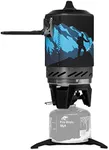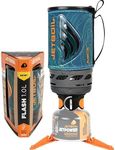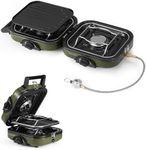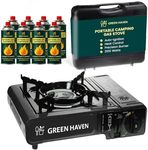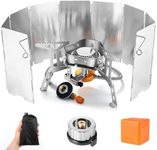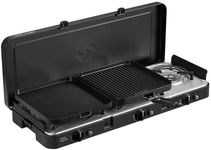Buying Guide for the Best Camping Stoves
Choosing the right camping stove can make a big difference in your outdoor cooking experience. Whether you're a solo backpacker or camping with a group, the right stove will help you prepare meals efficiently and safely. When selecting a camping stove, consider factors such as the type of fuel it uses, its weight and portability, cooking power, and ease of use. Understanding these key specifications will help you find the best fit for your needs.Fuel TypeThe type of fuel a camping stove uses is crucial because it affects the stove's performance, availability of fuel, and environmental impact. Common fuel types include canister fuel, liquid fuel, alcohol, and wood. Canister stoves are convenient and easy to use, making them great for beginners and short trips. Liquid fuel stoves are versatile and perform well in cold weather, ideal for extended trips and international travel. Alcohol stoves are lightweight and simple, suitable for ultralight backpackers. Wood stoves use natural fuel sources, which can be sustainable but require more effort to gather fuel. Choose a fuel type based on your trip duration, location, and cooking needs.
Weight and PortabilityWeight and portability are important considerations, especially for backpackers who need to carry their stove over long distances. Lightweight stoves, typically under a pound, are ideal for backpacking and solo trips. Heavier stoves, which can weigh several pounds, are better suited for car camping or group trips where you don't need to carry the stove far. Consider how much weight you can comfortably carry and how compact the stove needs to be for your specific camping style.
Cooking Power (BTUs)Cooking power, measured in British Thermal Units (BTUs), indicates how quickly a stove can heat food and boil water. Higher BTU ratings mean faster cooking times, which can be beneficial for preparing meals quickly. Stoves with lower BTUs are more fuel-efficient and suitable for simmering and cooking delicate foods. For quick boiling and cooking for larger groups, look for stoves with higher BTUs (around 10,000 BTUs or more). For solo trips or when fuel efficiency is a priority, stoves with lower BTUs (around 5,000-8,000 BTUs) may be sufficient.
Burner ConfigurationThe burner configuration affects how many pots or pans you can use at once and the overall cooking experience. Single-burner stoves are compact and lightweight, ideal for solo campers or those with minimal cooking needs. Double-burner stoves offer more cooking flexibility and are great for preparing multiple dishes simultaneously, making them suitable for group camping. Some stoves even have multiple burners with different heat outputs, providing versatility in cooking. Choose a burner configuration based on the number of people you're cooking for and the complexity of your meals.
Ignition SystemThe ignition system determines how you light the stove. Manual ignition stoves require a lighter or matches, which can be reliable but may be challenging in windy or wet conditions. Piezo ignition stoves have a built-in igniter that creates a spark, making them easier to light without additional tools. While piezo igniters are convenient, they can sometimes fail, so it's always good to have a backup lighter or matches. Consider your comfort level with lighting a stove and the conditions you'll be camping in when choosing an ignition system.
Wind ResistanceWind resistance is important for maintaining a consistent flame and efficient cooking in outdoor conditions. Some stoves come with built-in wind screens or have designs that naturally protect the flame from wind. Others may require additional wind screens or strategic placement to shield the flame. If you often camp in windy areas, look for stoves with good wind resistance features to ensure reliable performance. Assess the typical weather conditions of your camping destinations to determine the level of wind resistance you need.
Ease of Use and MaintenanceEase of use and maintenance are key factors for a hassle-free cooking experience. Stoves with simple designs and straightforward controls are easier to operate, especially for beginners. Consider how easy it is to set up, ignite, and adjust the flame. Maintenance involves cleaning and occasionally replacing parts, so look for stoves with accessible components and clear instructions. If you prefer minimal maintenance, opt for stoves known for their durability and ease of cleaning. Your comfort with stove operation and maintenance will guide you in choosing the right model.

